The New York City Ballet performs Balanchine’s Jewels.
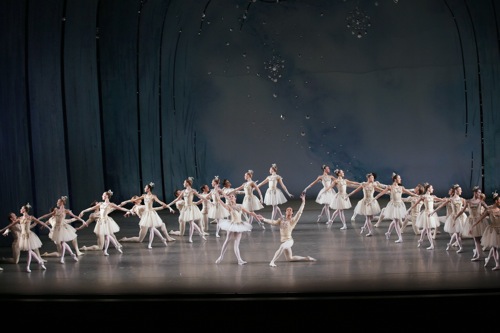
The New York City Ballet in Balanchine’s three-part Jewels. Maria Kowroski and Tyler Angle lead the Diamonds portion. Photo: Paul Kolnik
To see George Balanchine’s 1967 Jewels again at its first performance during the New York City Ballet’s winter season is to be delighted all over again. In choreographing its three separate but united ballets, Balanchine absorbed and brilliantly interpreted three diverse musical styles, the threads of narrative and atmosphere that clung to the music, and the sparkle and gleam of jewels that he saw on a visit to the Van Cleef & Arpels store on 5th Avenue.
The ballets that make up Jewels also hint the national styles that imbue their music. Rubies may be set to music by a Russian, Igor Stravinsky, but it has the propulsive speed, athletic zest, and swinging hips of American jazz. Diamonds, with its Tchaikovsky music, evokes the world of Russian ballet into which Balanchine (like Stravinsky) was born.
Emeralds, the first ballet of the evening, speaks French. It is set to selections from the impressionistic incidental music that Gabriel Fauré composed to accompany Maurice Maeterlink’s medieval fantasy of a play, Pelléas et Mélisande, plus additional selections from the music he created to embellish Edmond Haraucourt’s play Shylock (loosely based on Shakespeare’s The Merchant of Venice).
The two plays’ themes of love—its mysteries, its struggles, and its betrayals—drift lightly via the music into the choreography. And into its décor. As in all three ballets, Peter Harvey’s set design involves variously suspended arrays of ersatz gems that quiver and twinkle in Mark Stanley’s lighting. But for Emeralds, these hang in front of cloudy greenery, a forest so impressionistically rendered that it’s barely recognizable as such.
This magical green world is inhabited by a bevy of nymphs (ten in all), a sprightly threesome, and two princesses and their cavaliers. The leading dancers’ costumes (among Karinska’s best) are almost identical to those of all the other women; only the quantity of jewels sewn onto their bodices reveal their status. They might just have wandered away from their friends for a tryst or to be alone, wending—with or without their lovers— through avenues formed by the ensemble of women women. I find it illuminating to remember that Maeterlink’s Mélisande was first discovered by her jealous husband-to-be alone near a forest pool, when I watch Ashley Bouder dance the solo that Balanchine made for his French ballerina, Violette Verdy.
This solo, for me, is one of Emeralds‘ brightest gems. Left alone on stage, with music swirling around her, Bouder stands and plays softly in the air with her hands, as if acknowledging breeze-stirred foliage; revolving on pointe, she bends toward surrounding grass or water. She ripples her arms, briefly lifts her skirts as if to wade. I’m being fanciful, I know. But even as Bouder takes off, steps into arabesques, springs into the air, and exults in having the space to herself (her usually attentive partner, Jared Angle, is off about his own business), this choreography is as changeable as the wind. You keep seeing what might be familiar ballet moves from slightly unfamiliar angles or in unusual contexts. All this Bouder conveys with a freedom and openness and playfulness very different from the steel-toed incisiveness she’s known for.
The solo danced by Sara Mearns to Fauré’s “Sicilienne,” is calmer, more introspective, and she gives it a quality both luscious and pensive. Her duet with Jonathan Stafford to the “Nocturne” from Shylock builds on these qualities; they enter together walking dreamily—she on pointe— like two lovers who understand each other. Balanchine gives them some glinting little accents too; once, they lift their arms in several tiny jerks; later she raises one leg the same way.
Mearns’s solo and the duet are separated by a lively pas de trois—performed by Ashley Laracey, Antonio Carmena, and Erica Pereira. I scribbled “facets” on my program, suddenly realizing that not only does Balanchine refer to the facetted surface of jewels in his symmetrical ensemble designs, he sometimes twists the movements themselves in order to display their facets. Laracey, Carmena, and Pereira—often linked like ice skaters— perform with sprightly camaraderie and sparkling technique. I’ve never seen him look so at ease in boldness.
Emeralds seems to happen in a dream world, however energetic the dancing gets. This seems especially true in the beautiful pas de sept that Balanchine added after the premiere of Jewels. The two principal couples and the trio begin to wander, each dancer on a solitary track before they chain or cluster slowly in elegiac patterns. In the final moments, the four women drift away, and the three men drop to one knee, all facing the same diagonal and reaching toward a distance beyond the stage. The music for this section is “The Death of Mélisande.”
There’s nothing dreamlike about Rubies. When pianist Susan Walters and the New York City Ballet Orchestra (under guest conductor Roberto Minczuk) tear into Stravinsky’s Capriccio for Piano and Orchestra, a small army is ready for it, ranged in four units of one man and two women. They’re wearing shiny red outfits—tunics for the men and very short skirts for the women that are separated into flame-like strips. The trios surround a tall, slender leader, Teresa Reichlen. She sets the tone; like her, all the women swing their hips forward and strike pin-up-girls poses, but only the marvelous Reichlen has legs so long that when she slings one insouciantly into the air behind her, you imagine it could knock down any opponent. In one inspired passage, the four ensemble men surround her and reverently move her limbs into various attractive positions, as if she were a large doll that someone had been nice enough to give them.
Many of the ensemble dancers in Rubies, along with the other principals, Megan Fairchild and Joaquin De Luz, are considerably smaller than Reichlen. An interesting effect. Fairchild and De Luz perform their duets charmingly. She is more outgoing than I’ve seen her be—responding playfully to his roguishness, as the two of them spring and spin and crouch and strut. Their feet are flexed as often as they’re pointed, and a little shimmying exchange acknowledges them as fond sparring partners.
At moments, the piano behaves like a cimbalom, giving a gypsy undertone to the jazzy athletics. The women unreel chains of piqué turns; the men show how high they can jump. Fast! Hot! That’s rubies for you.
Diamonds utilizes to all but the first of the five movements that make up Tchaikovsky’s Symphony No. 3 in D Major. As is proper for a closer, this ballet has more dancers in it than Jewels’ two preceding works. Beneath glittering stones bunched into shapes resembling chandeliers, twelve women in white knee-length tutus dance. Partners eventually turn up for all of them. Four women higher in status at this musical court have men equal to them in rank. But the prince and princess rendezvous alone, slowly walking toward each other to the mournful melody played by a solo bassoon.
This long duet to the Andante Elegiaco, like several other Balanchine duets to Tchaikovsky’s adagio music, seems to hint at a theme of 19th-century ballets laid in fairytale kingdoms. The man is subservient (this one bows often), yet supportive, and enamored of a remarkable and beautiful female, while she—fond enough of him to swoon backward into his arms—keeps looking and reaching into the distance, as if compelled by some other force, some other yearning. These two people do, however, leave together.
At the first performance of Jewels this season, these roles were taken by Maria Kowroski and Tyler Angle. Kowroski combines a certain reticence with the large-scale dancing that her height emphasizes so thrillingly. Sometimes her mind seems elsewhere instead of on Angle. But he is a true prince of a partner. He doesn’t just help her to do what she couldn’t manage alone; he brings warmth and an unwavering focus to his task. He’s all hers and glad to be. Caught in what can begin to seem like a glut of slowly achieved arabesques on her part, he treats each one with interest.
Despite its beauties, I find Diamonds less enthralling than Emeralds and Rubies. By the end of it, with it polonaise and its rushing, changing crowd patterns, you seem less to be watching diamonds form, dissolve, and reform than a snow storm ordered by a master.
The living jewels of the evening are, of course, the performers. Who inherited their roles from dancers Balanchine adored and whose facets he never tired of exploring.

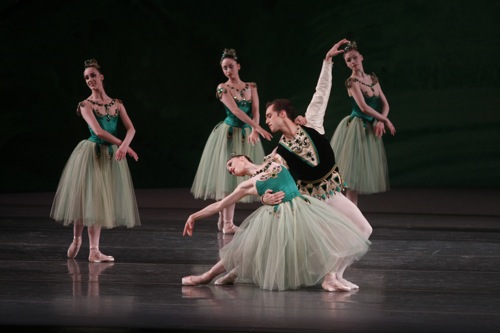
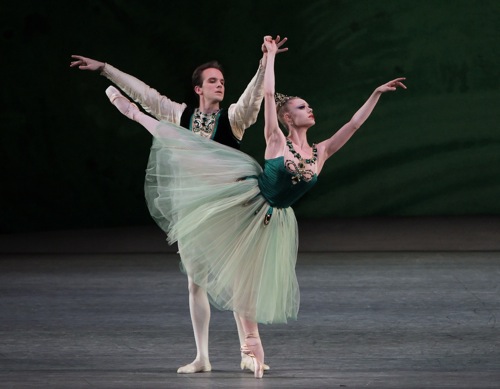
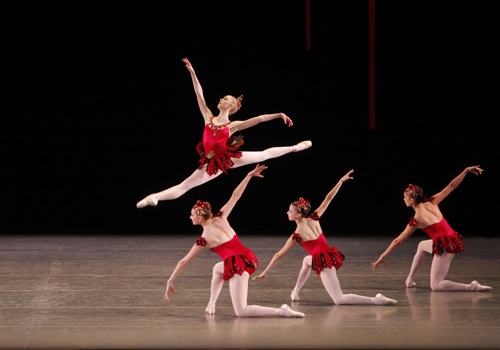
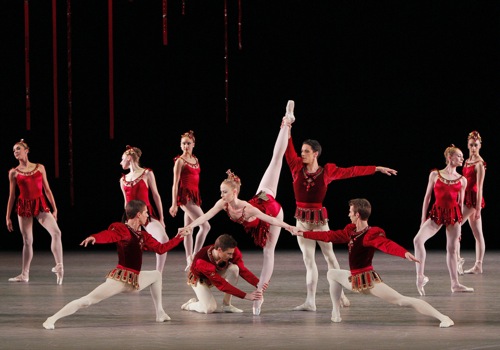
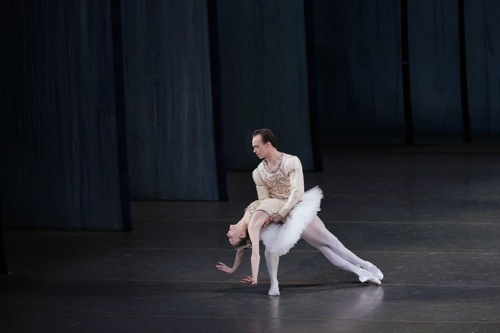
It’s always wonderful to revisit Jewels, and your piece, Deborah, as always, brings addtional information I hadn’t known: specifically some of the dramatic contexts of the Faure music in Emeralds. I’ve seen Bouder do Emeralds, as well as Rubies–I’m not sure, but I think she may be the only dancer in the company who performs all three. You’re right that if we think of her as a pure classicist–and she’s one of the company’s purest–then watching her in the Faure comes as a surprise. I think it’s a measure of her extraordinary versatility–you get the sense she can do anything, and at any moment she can convince you that she’s a pure Romantic or a pure modernist as well.
Thanks, Deborah.
Jay
I do love Emeralds best of the three, but after seeing a number of performances of Diamonds as a stand-alone ballet, I appreciate it much more than I have in the past. I think it suffers for being the last ballet in the program. It is, as so many other people have observed, as pocket version of a big Petipa ballet, and the opening of the duet, where the two leads take that zig-zag pathway to each other, stands in for all kinds of plot devices in the 19th century canon.
Does the NYCB orchestra really use a cimbalom when performing Stravinsky’s score? I wasn’t aware that it was part of the orchestration.
I’m glad that Jeff Morris challenged my mention of the cimbalom. I obviously misread the NYCB’s program information, and I thought I heard the instrument. Now I’ve done a little research. Boosey and Hawkes, in describing the score for Stravinsky’s Capriccio, provides this information: “Stravinsky compared the second movement cadenza, with its cimbalom-like hammerings and scales, to ‘a kind of Rumanian restaurant music.'” In other words, the piano in disguise. I’ve edited my review to reflect that fact.